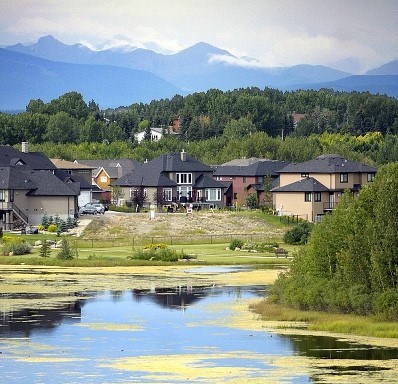Work on the Cochrane Lake Improvement Plan continues into 2025 with a solution to improve water quality and drainage from the lake.
Rocky View County (RVC) council gave administration the green light to continue exploring working towards the construction of a berm along the southern residential portion of Cochrane Lake with increased discharge to Horse Creek during their Jan. 7 council meeting.
RVC Reeve Crystal Kissel said they’re not ready to fully approve the solution, as they still need to iron out the details and look at who’s paying for what. Administration noted they would be coming forward with details and several funding strategies at an upcoming meeting.
The berm is meant to raise the water level and create a deeper, algae-resistant lake with enhanced stormwater storage capacity.
The existing pumping and lift station infrastructure would be upgraded, as well as a mechanical treatment system to be used on the lake to disrupt the growth of cyanobacteria and bio-manipulation in the form of wetland plantings to improve water quality, said Brenda Mulrooney, RVC’s supervisor of capital and engineering services, during her presentation to council.
Mulrooney said this solution has the greatest chance of success but also poses some challenges in requiring water quality standards for the increased water discharge.
The preliminary berm design shows a three-metre flat top that could be used as a pathway by developers. Details are yet to be announced on the final design.
The berm and increased discharge solution is estimated to cost $5.1 million, far less than the other two options presented.
Council also green-lit the continued negotiations with contributing landowners to formalize a cost-sharing agreement, inclusive of grant and other funding opportunities such as levies.
The total lands that divert drainage to Cochrane Lake, either directly or indirectly, equates to 1268 ha. There is limited servicing for water and wastewater for the Cochrane Lake area and there are restrictions in place for discharge to Calgary, Mulrooney said.
The existing Capacity Allocation Agreement between the County and developers has reserved capacity for Macdonald lands, Neighbourhood C and Cochrane North developments. The total area for these three developments plus the existing communities of Monterra and the southern hamlet equates to approximately 477.74 ha.
Coun. Kevin Hanson questioned if this lake would still be considered for recreational opportunities despite contamination found at the bottom of the lake. Administration noted the lake is under control of Alberta Environment and Parks, and that discussions around this in the future would be possible. The current area structure plan supports recreation around the lake, according to administration.
Looking Back
Council previously acknowledged that a strategy is needed to resolve the water quality issues of Cochrane Lake, to mitigate against future flooding, and to upgrade existing infrastructure to facilitate future development in the area, stated Mulrooney. The original solution was to divert the drainage to the Bow River via a dedicated pipeline from Cochrane Lake, which included an estimated cost of $11.1 million.
Cochrane Lake has no natural outlet and water quality has been an issue as minerals and nutrients entering the lake from stormwater runoff are not adequately flushed out and continue to accumulate in the Lake causing undesirable conditions, according to council documents.
In 2016, a pump station and outlet pipeline were constructed by the County to release water from the lake to Horse Creek. This discharge has served two purposes of lowering lake levels and allowing for the removal of nutrients negatively impacting water quality.
In 2023, the Cochrane Lake Revitalization Plan was presented with water quality improvements, a recreational pathway system, and flood mitigation solutions for Cochrane Lake.
This plan also outlines the lands that divert drainage to Cochrane Lake and mandates a stormwater solution for future development.
One year ago, the Terms of Reference for the plan was approved alongside a $90,000 budget adjustment to complete the work. By November 2024, ISL had completed required field testing and analysis of the findings to formulate the Cochrane Lake Improvement Plan Review.
Several stormwater management solutions were explored, including a dedicated pipeline to the Bow River, dredging of Cochrane Lake, and construction of a berm with continued discharge to Horse Creek. Dredging of Cochrane Lake included an estimated cost of $66.1 million.




